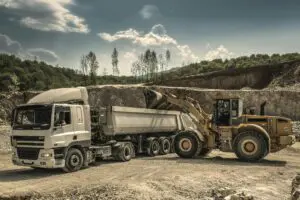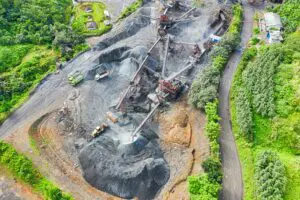As the push for green energy gathers more momentum, demand for the metals that go into zero-emission technologies is rising while uranium spot prices have seen a steady climb since January.
Here’s a list of the top ten Canadian-headquartered base metal and uranium juniors with no production. The ranking is based on the companies’ market capitalization as of June 1, as compiled by Costmine Intelligence.

#1 – Filo Mining
Market Cap: $2.6 billion
Filo Mining (TSXV: FIL) traded spots with NexGen Energy (TSX: NXE; NYSE: NXE) for the top spot this year even though Filo’s market cap fell by more than 11%. A member of the Lundin Group of companies, Filo’s flagship project is its Filo del Sol copper-gold project in South America. The high-sulphidation epithermal copper-gold-silver deposit is associated with a large porphyry copper-gold system.
Filo del Sol is in Argentina’s San Juan province and the adjacent Atacama region of northern Chile, straddling the border of the two countries. The project hosts proven and probable reserves of 259.6 million tonnes grading 0.39% copper, 0.34 gram gold per tonne and 16 grams silver for 2.2 billion lb. copper, 2.8 million oz. gold and 133.3 million oz. silver, according to an updated prefeasibility study in February.
The study gave the project a US$1.3 billion after-tax net present value (NPV) at an 8% discount and an internal rate of return (IRR) of 20%. Initial capital costs are forecast at about US$1.8 billion, with sustaining costs of $140 million over a 13-year mine life.
Filo currently has nine rigs drilling at the site, with 40,000 metres planned for the year.
#2 – NexGen Energy
Market Cap: $2.52 billion
NexGen Energy fell to second place, with its market cap falling by more than 16% from last year. Meanwhile, the spot price for uranium has continued to climb this year, reaching US$57.75 per lb. U3O8 in mid-June.
NexGen is focused on the southwestern area of the highly prospective Athabasca basin of Saskatchewan and Alberta. Its 1,900-sq.-km land package includes its Rook 1 project, the largest development-stage uranium deposit in Canada. Rook hosts the Arrow deposit and the South Arrow, Harpoon, Bow and Cannon discoveries.
Rook hosts probable reserves of 4.5 million tonnes grading 2.37% uranium oxide for 239.6 million contained lb., according to a feasibility study published in 2021. The project would produce 29 million lb. of U3O8 annually for the first five years over a 10.7-year mine life. Its capex is estimated at $1.3 billion, with operating costs of US$5.69 per lb.
In June, NexGen began a 17,000-metre summer drilling program on the SW1 and SW2 properties at Arrow. The program will bring the year’s total planned exploration metres to 22,500. The company aims to start early construction works in the first half of the year and final licensing by the third quarter. Production is targeted to start in 2027.
#3 – Denison Mines
Market Cap: $1.1 billion
Denison Mines (TSX: DML; NYSE-AM: DNN), also focused on uranium in the Athabasca basin, remains in third position for the third year in a row, though its market cap is down by 10% from 2022. Denison recently released a feasibility study for the Phoenix deposit at its Wheeler River project, and updated cost estimates for its prefeasibility stage Gryphon deposit.
The feasibility study outlines preproduction capital costs at Phoenix, which is planned as an in-situ recovery (ISR) operation, at just under $420 million. The study forecasts 56.7 million lb. of U3O8 will be recovered over the deposit’s 10-year life, with production over the first five years averaging 8.4 million lb. annually. Phoenix has an NPV of $1.6 billion (using an 8% discount rate) and an IRR of 90%, with a payback period of 10 months.
Initial capital costs at Gryphon, which will be developed as a conventional underground mine, are pegged at $737.4 million. It should produce an average of 7.6 million lb.
U3O8 per year over 6.5 years. The project’s base case after-tax NPV is $864.2 million and its IRR is 37.6%, with a payback period of 23 months.
Denison also holds the McLean Lake deposit and mill, in which the company retains a 22.5% interest. The McLean Lake mill processes ore from the Cigar Lake uranium mine operated by Cameco (TSX: CCO; NYSE: CCJ).
Wheeler River is a joint venture between Denison (95% and operator) and JCU (Canada) Exploration, of which Denison owns 50%.
#4 – NGEx Minerals
Market Cap: $1.1 billion
NGEx Minerals (TSXV: NGEX; US-OTC: NGXXF) rose five places on the list from last year, and its market cap almost tripled. The Lundin Group-copper and gold explorer holds its flagship Los Helados project in Chile, and other projects in Argentina.
On April 13, the company reported some of the highest grades it has yet seen at Helados. Highlights from Helados’ Fenix zone include hole LHDH081-2, which returned 343.8 metres at 0.9% copper-equivalent, including 63.8 metres at 1.25% copper-equivalent; and LHDH081-3 that returned 234 metres at 0.9% copper-equivalent, including 28 metres at 1.49% copper-equivalent.
Its 2022-2023 exploration program is expected to drill 15,000 metres. It is now winding down with the approach of winter in the Andes and planning for a 2023-2024 field season is underway.
An updated resource in 2019 estimated Los Helados hosts 2.1 billion indicated tonnes at 0.38% copper, 0.15 grams gold per tonne and 1.37 grams silver for 17.6 billion lb. of copper, 10.1 million oz. of gold and 92.5 million oz. of silver. Inferred resources total 827 million tonnes at 0.32% copper, 0.1 gram gold and 1.32 grams silver for 5.8 billion lb. of copper, 2.7 million oz. of gold and 35.1 million oz. of silver. A preliminary economic assessment (PEA) was completed for the project in 2014.
#5 – Solaris Resources
Market Cap: $815 million
Solaris Resources (TSX: SLS; US-OTC: SLSSF) has dropped one place in the ranking as its market valuation fell by almost a third from last year.
The company has several copper prospects in Latin America, with its main focus on the 268-sq.-km Warintza project in Ecuador, which hosts a cluster of copper porphyry deposits featuring a large-scale, high-grade open-pit resource inventory at Warintza Central. Warintza is located about 60 km north of Lundin Gold’s (TSX: LUG) Fruta del Norte gold mine.
On June 14, the explorer reported the discovery of a new porphyry deposit at the Patrimonio target at Warintza Central, the sixth porphyry deposit found at Warintza. Assay results were pending at press time.
Warintza Central hosts an in-pit indicated resource of 579 million tonnes grading 0.59% copper equivalent for 2.7 million tonnes of copper, 150,000 tonnes of molybdenum and 930,000 oz. of gold at a 0.3% copper equivalent cut-off, according to an April 2022 technical report. Inferred resources come to 887 million tonnes grading 0.47% copper equivalent for 3.5 million tonnes of copper, 130,000 tonnes of molybdenum and 1.1 million oz. of gold.
That report recommended the completion of a PEA, and Solaris has a budget of $1.4 million for the study.
#6 – Foran Mining
Market Cap: $793.3 million
Foran Mining (TSXV: FOM) falls one spot in the rankings despite the copper-zinc developer’s market cap rising by 26% over last year. Foran’s flagship project is the McIlvenna Bay volcanogenic-hosted massive sulphide (VMS) deposit in southeastern Saskatchewan. Its other regional assets include Bigstone, Balsam, and interests in other nearby properties.
Foran’s winter drilling program this year yielded high grade results from its new Tesla target, south of McIlvenna Bay. On May 25, the company reported assay highlights including 3.5 metres grading 6.47% copper, 1.49% zinc, 86.5 grams silver per tonne and 0.03 gram gold (6.76% copper equivalent) in hole TS-23-10; including 2.1 metres at 9.95% copper, 0.99% zinc, 127.8 grams silver and 0.04 gram gold (9.97% copper equivalent).
A February 2022 feasibility study for McIlvenna Bay forecast a mine life of about 20 years based on a throughput rate of 4,200 tonnes per day and estimated average annual production of 72.8 million lb. copper-equivalent for the first 15 years. Probable mineral reserves total 25.7 million tonnes at 1.23% copper, 2.39% zinc, 0.47 gram gold per tonne and 15.35 grams silver for a copper-equivalent grade of 2.51%.
In December 2022, Foran closed a senior secured credit facility with Sprott Resource Lending for US$150 million that will be used for construction of McIlvenna Bay.
#7 – Fission Uranium
Market Cap: $398.8 million
Dropping one spot in the rankings from last year, Fission Uranium’s (TSX: FCU; US-OTC: FCUUF) flagship project is the Patterson Lake South (PLS) asset on the southwestern edge of the Athabasca basin. The 310.4-sq.-km PLS hosts the high-grade and near-surface Triple R deposit.
The British Columbia-based company announced on June 27 that data from its completed 12-hole drill program would be used to optimize the design of the underground mine infrastructure and tailings management facility. Permitting efforts towards a construction decision are underway, and Fission has submitted an application to the Canadian Nuclear Safety Commission for a licence to build the mine and mill at PLS.
The Triple R deposit at PLS contains probable reserves of 3 million tonnes of uranium grading 1.41% U3O8 for 93.7 million lb. of contained metal, according to a feasibility study published in January. The project has an after-tax NPV of $1.2 billion (at an 8% discount), and an IRR of 27.2%. Fission estimates a three-year construction period for the underground mine, starting in 2026, with production targeted for 2029. It will have a 10-year mine life.
#8 – Arizona Metals
Market Cap: $383.9 million
Arizona Metals (TSX-V: AMC; US-OTC: AZMCF) drops one place in the top 10 this year. The company holds the 5.4-sq.-km Kay project that sits on the namesake past-producing mine in Yavapai County, Ariz., about 70 km north of Phoenix.
On June 26, the explorer reported drill result highlights of 25 metres grading 2.7% copper-equivalent, including 3.2 metres at 6.3% copper-equivalent from 476.3 metres depth, in hole KM-23-106. The same hole cut 49.2 metres at 2.4% copper-equivalent (including 10.4 metres at 6.4% copper-equivalent) 17 metres further downhole.
The June results conclude the company’s 83,400 metres of drilling at Kay, completing its Phase 2 drill program that started in early 2021. Following the drilling of priority targets, the company plans to finalize an initial resource estimate. Current metallurgical testing at Kay is expected to be completed in the second half of 2023.
An historical reserve estimate for Kay outlined 6.4 million tonnes grading 2.2% copper, 3.03% zinc, 55 grams silver per tonne and 2.81 grams gold at the VMS deposit. The mine produced about 296,000 lb. of copper, 13,000 lb. of lead, 2,700 oz. of silver and 150 oz. gold in the 1900s.
The company also owns the Sugarloaf Peak property, about 200 km west of Phoenix.
#9 – Los Andes Copper
Market Cap: $351.8 million
Los Andes Copper (TSX-V: LA) is a Vancouver-based explorer whose flagship project is the Vizcachitas copper-molybdenum project in central Chile.
Los Andes began exploring Vizcachitas in 2007, acquired 100% ownership in 2010 and started developing a new geological model.
A prefeasibility study released in February showed Vizcachitas is a tier 1 asset and among the largest advanced copper deposits in the Americas. With a post-tax NPV of US$2.8 billion (at an 8% discount rate) and an IRR of 24%, the study estimates Vizcachitas will have a mine life of 26 years. Its preproduction capital costs stand at $2.4 billion. It would produce 8.7 billion lb. copper, 273.3 million lb. molybdenum, and 32.7 million oz. silver, based on updated proven and probable reserves of 1.2 billion tonnes grading 0.36% copper, 136 parts per million molybdenum and 1.1 grams silver per tonne.
In mid-June, Los Andes announced that Chile’s environmental court ruled the company could resume its 18,000-metre drill program at Vizcachitas. A March 2022 court order had suspended drilling on concerns about its impact on the habitat of the vizcachas, a small rabbit that is the food source for the Andean cat, a protected species.
#10 – Marimaca Copper
Market Cap: $330.8 million
Marimaca Copper (TSX: MARI) is a Vancouver-based company advancing its namesake flagship project in the northern Antofagasta region of Chile.
First discovered in 2016, the company published an initial resource for the project in 2019, followed by a PEA in 2020 that confirmed its potential to be a low-cost, high-margin mine.
An updated resource released in May 2023 said the Marimaca Oxide Deposit (MOD) has measured and indicated resources of 200.3 million tonnes grading 0.45% copper for 900,000 tonnes of contained metal. Inferred resources come to 37.3 million tonnes at 0.38% copper for 141,000 tonnes of metal. The update was based on 28,374 metres of drilling completed since the previous estimate of October 2022.
Marimaca has completed 139,164 metres of drilling since the deposit was discovered. A feasibility study is planned for the project in late 2023.





















